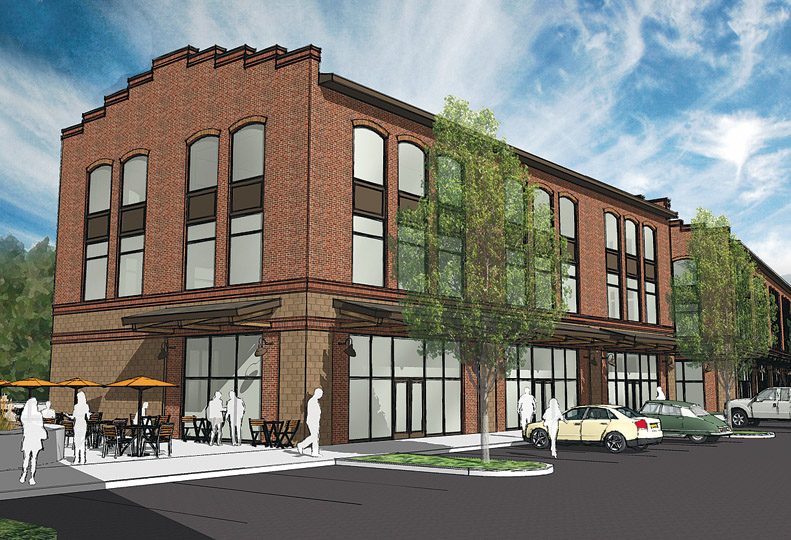$15 million-plus office complex eyed along Spokane River
Project near U-District to include four buildings

Spokane developer and contractor Eric Brown says he plans to construct a $15 million-plus office complex near the south bank of the Spokane River, on the eastern edge of the University District.
The project, tentatively named Spokane River Properties Development, would have four three-story office buildings and one single-story retail structure, Brown says.
Brown’s real estate holding company, Brown Properties LLC, owns the property, which is comprised of nearly 7 acres of land with 1,900 linear feet of river frontage, the center of which lies under the Hamilton Street bridge. Two office buildings and the retail building would be east of the bridge, which is formally named the James E. Keefe Bridge, and a pair of office buildings would be west of it.
The project hinges on the next phase of construction for Martin Luther King Jr. Way, Brown says.
“Before I pull the trigger, I want to make sure the street is going through,” he says.
Martin Luther King Jr. Way, which connects to Division on its west end, currently terminates at North Sherman Street, roughly 300 yards west of the Spokane River Properties site.
The city of Spokane’s planned extension would skirt the south edge of the development site and continue on the current Erie Street right of way to Trent Avenue.
City engineer Dan Buller says design work is nearly complete for the extension, and the city is working on acquiring property from BNSF Railway Co. and a private landowner.
Then, depending on Washington state Department of Transportation approval, construction could begin in late summer and carry over into 2016, Buller says.
Brown Properties has submitted a predevelopment application, which tentatively begins the planning process with the city for the Spokane River Properties Development. Brown Properties also has applied for a building permit to construct infrastructure and site improvements on the property.
Brown says he hopes to begin site work when the city starts work on the street extension.
“I also hope to start work on one of the office buildings this year,” he adds.
Two of the office buildings each would have a total of 24,000 square feet of space, and two would have 15,000 square feet each, he says. The retail building would have 3,000 square feet of space, bringing the combined square footage in the complex to 81,000 square feet. The development also would have a surface lot with close to 200 parking spaces.
Brown’s construction company, Brown Contracting & Development Inc., of Spokane Valley, will be the contractor on the project, he says.
The property previously had been the site of two facilities collectively known as the Spokane Gas Plant, which manufactured and processed coal gas and coal tar from the early 1900s to 1948.
Washington Water Power Co., the Spokane-based energy company known today as Avista Corp., acquired the property through a merger with Spokane Natural Gas Co. in 1958. WWP continued to distribute natural gas from the site until about 1963.
Brown’s father Richard Brown, founder of Brown Building Materials, leased the property from WWP until 1978, when he purchased it. Brown Building Materials took up most of the site until a fire gutted the main building there in 2000, Brown says.
“My father had a lot of stuff,” he says.
After the fire, Brown Building Materials, now owned by his brother Ron Brown, moved to a smaller location, at 112 N. Erie, just east of the project site. Subsequently, Brown Properties took ownership of the project site.
Also in the early 2000s, Avista and BNSF participated in cleanup actions to remediate contamination from historic coal-gas and coal-tar manufacturing on a portion of the site. As part of the cleanup, underlying contaminated soils have been capped with a gravel surface to prevent exposure to contaminated soils.
Patrick Cabbage, Washington state Department of Ecology’s site manager for the cleanup, says environmental covenants restrict certain activities on the property.
“Anything that’s going to disturb the ground needs to involve Ecology to ensure it’s protective of groundwater and the Spokane River,” he says.
Ecology determined in 2010 that site wasn’t adversely impacting the Spokane River, and no further cleanup actions were required at that time. Ecology plans to conduct a second cleanup review at the site this year.
Brown says the Spokane River Properties Development wouldn’t disturb contaminated soils. “We can build over it,” he says.
The city of Spokane in 2002 approved a binding site plan and conditional-use permit for the property, which grandfathers the shoreline setback at 50 feet, Brown says.
The city later updated its comprehensive plan, which requires a minimum 150 foot shoreline setback for new development applications.
Brown says no tenants are lined up for the Spokane River Properties Development yet, although he anticipates the development would be attractive to tenants looking to locate near the University District or the Spokane River.
While the property has been overshadowed by the James E. Keefe Bridge since the bridge was constructed in 1983, it likely would be much more visible when Martin Luther King Jr. Way is extended, Brown asserts.
“People are going to say, ‘Where did this come from?’” he says. “Right now, no one knows it’s there. There’s no way to get there now, except from Erie.”
Brown says preliminary building designs harken back to historic brick-and-glass warehouse buildings once prominent along the river in the industrial part of the East Central district.
He says structures on the site would be similar in appearance to the 1907-era Spokane & Inland Empire Railroad Building at McKinstry Station that Seattle-based McKinstry Co. redeveloped recently across the river from the project site.
Nystrom+Olson Architecture provided preliminary design work, although Brown says he hasn’t selected an architect yet for the overall project.
The Spokane office of Seattle-based DCI Engineers is the civil engineer on the project.
Related Articles
Related Products





